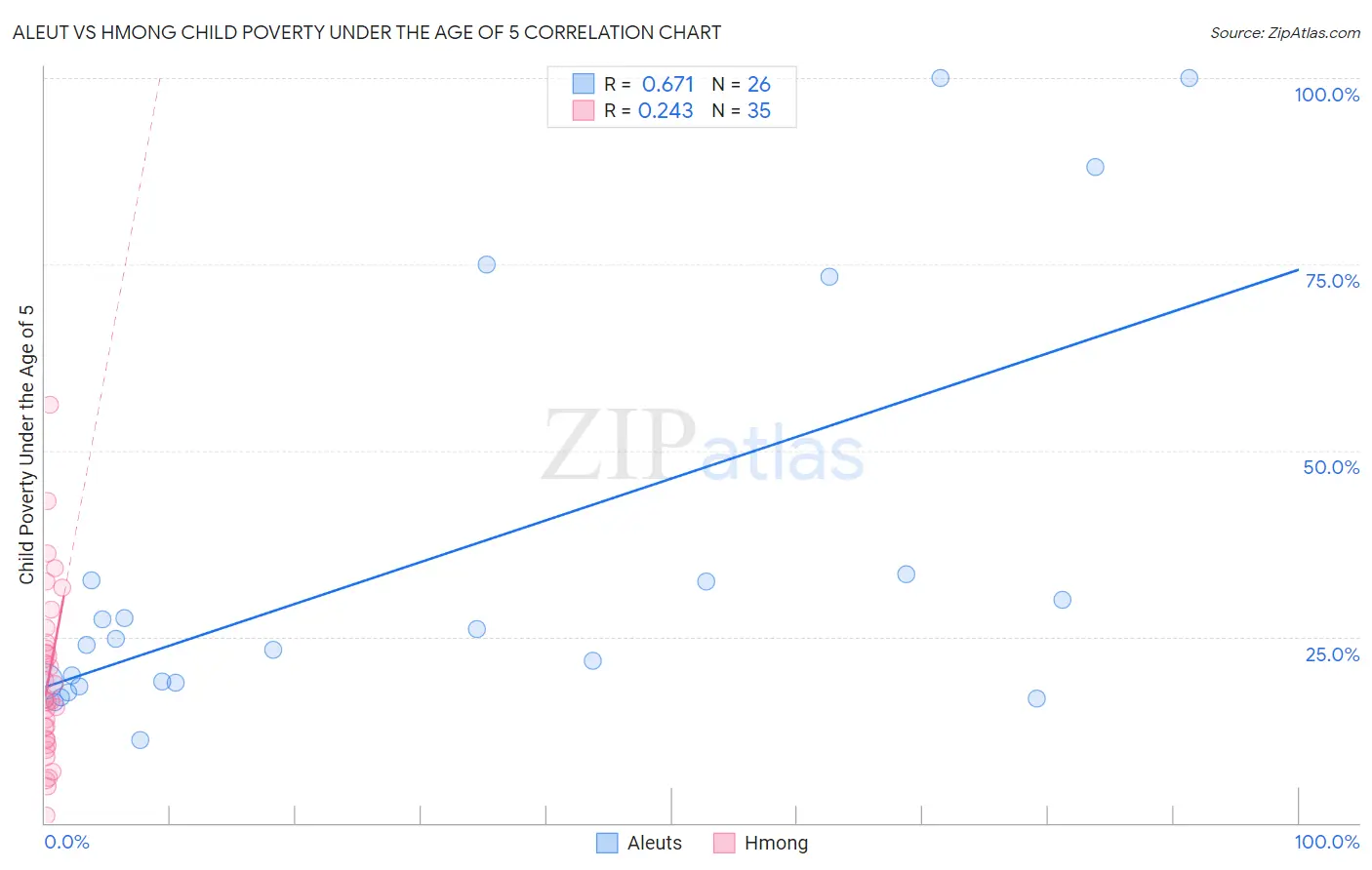Aleut vs Hmong Child Poverty Under the Age of 5
COMPARE
Aleut
Hmong
Child Poverty Under the Age of 5
Child Poverty Under the Age of 5 Comparison
Aleuts
Hmong
20.3%
CHILD POVERTY UNDER THE AGE OF 5
0.1/ 100
METRIC RATING
266th/ 347
METRIC RANK
18.5%
CHILD POVERTY UNDER THE AGE OF 5
5.0/ 100
METRIC RATING
216th/ 347
METRIC RANK
Aleut vs Hmong Child Poverty Under the Age of 5 Correlation Chart
The statistical analysis conducted on geographies consisting of 61,069,429 people shows a significant positive correlation between the proportion of Aleuts and poverty level among children under the age of 5 in the United States with a correlation coefficient (R) of 0.671 and weighted average of 20.3%. Similarly, the statistical analysis conducted on geographies consisting of 24,630,682 people shows a weak positive correlation between the proportion of Hmong and poverty level among children under the age of 5 in the United States with a correlation coefficient (R) of 0.243 and weighted average of 18.5%, a difference of 9.2%.

Child Poverty Under the Age of 5 Correlation Summary
| Measurement | Aleut | Hmong |
| Minimum | 11.1% | 0.91% |
| Maximum | 100.0% | 56.2% |
| Range | 88.9% | 55.3% |
| Mean | 35.1% | 19.2% |
| Median | 24.3% | 16.5% |
| Interquartile 25% (IQ1) | 18.8% | 11.1% |
| Interquartile 75% (IQ3) | 32.6% | 24.2% |
| Interquartile Range (IQR) | 13.9% | 13.2% |
| Standard Deviation (Sample) | 27.1% | 11.6% |
| Standard Deviation (Population) | 26.5% | 11.5% |
Similar Demographics by Child Poverty Under the Age of 5
Demographics Similar to Aleuts by Child Poverty Under the Age of 5
In terms of child poverty under the age of 5, the demographic groups most similar to Aleuts are Spanish American Indian (20.2%, a difference of 0.13%), Immigrants from Liberia (20.2%, a difference of 0.24%), Barbadian (20.2%, a difference of 0.37%), Ottawa (20.3%, a difference of 0.39%), and Belizean (20.3%, a difference of 0.40%).
| Demographics | Rating | Rank | Child Poverty Under the Age of 5 |
| Immigrants | El Salvador | 0.2 /100 | #259 | Tragic 20.0% |
| Spanish Americans | 0.2 /100 | #260 | Tragic 20.1% |
| Immigrants | Bangladesh | 0.2 /100 | #261 | Tragic 20.1% |
| Liberians | 0.1 /100 | #262 | Tragic 20.2% |
| Barbadians | 0.1 /100 | #263 | Tragic 20.2% |
| Immigrants | Liberia | 0.1 /100 | #264 | Tragic 20.2% |
| Spanish American Indians | 0.1 /100 | #265 | Tragic 20.2% |
| Aleuts | 0.1 /100 | #266 | Tragic 20.3% |
| Ottawa | 0.1 /100 | #267 | Tragic 20.3% |
| Belizeans | 0.1 /100 | #268 | Tragic 20.3% |
| Immigrants | Burma/Myanmar | 0.1 /100 | #269 | Tragic 20.4% |
| Jamaicans | 0.1 /100 | #270 | Tragic 20.4% |
| Americans | 0.1 /100 | #271 | Tragic 20.5% |
| Immigrants | Jamaica | 0.1 /100 | #272 | Tragic 20.5% |
| Central Americans | 0.1 /100 | #273 | Tragic 20.6% |
Demographics Similar to Hmong by Child Poverty Under the Age of 5
In terms of child poverty under the age of 5, the demographic groups most similar to Hmong are Immigrants from Africa (18.6%, a difference of 0.20%), Immigrants from Panama (18.5%, a difference of 0.46%), Malaysian (18.4%, a difference of 0.66%), Delaware (18.7%, a difference of 0.95%), and German Russian (18.8%, a difference of 1.3%).
| Demographics | Rating | Rank | Child Poverty Under the Age of 5 |
| Spanish | 9.8 /100 | #209 | Tragic 18.2% |
| Panamanians | 9.7 /100 | #210 | Tragic 18.2% |
| Moroccans | 9.4 /100 | #211 | Tragic 18.2% |
| Nepalese | 8.7 /100 | #212 | Tragic 18.3% |
| Immigrants | Thailand | 8.6 /100 | #213 | Tragic 18.3% |
| Malaysians | 6.5 /100 | #214 | Tragic 18.4% |
| Immigrants | Panama | 6.0 /100 | #215 | Tragic 18.5% |
| Hmong | 5.0 /100 | #216 | Tragic 18.5% |
| Immigrants | Africa | 4.6 /100 | #217 | Tragic 18.6% |
| Delaware | 3.4 /100 | #218 | Tragic 18.7% |
| German Russians | 3.0 /100 | #219 | Tragic 18.8% |
| Immigrants | Azores | 2.6 /100 | #220 | Tragic 18.9% |
| Immigrants | Nigeria | 2.1 /100 | #221 | Tragic 19.0% |
| Alsatians | 1.7 /100 | #222 | Tragic 19.1% |
| Cubans | 1.7 /100 | #223 | Tragic 19.1% |